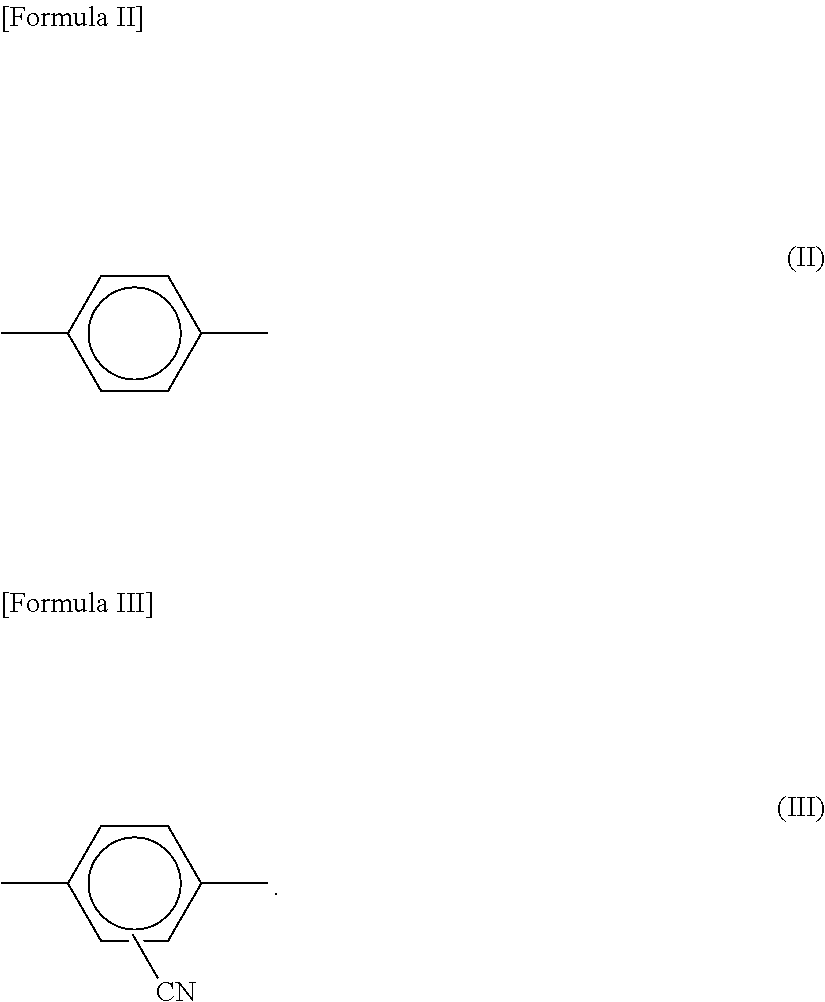High-strength copolymerized aramid fiber and preparing method therefor
a copolymerization and high-strength technology, applied in the direction of fibre treatment, monocomponent copolyamide artificial filament, filament/thread forming, etc., can solve the problems of reducing durability, affecting the health of the human body, and complicated manufacturing process, and achieves excellent solubility in organic solvents, low polydispersity index, and high intrinsic viscosity (iv)
- Summary
- Abstract
- Description
- Claims
- Application Information
AI Technical Summary
Benefits of technology
Problems solved by technology
Method used
Image
Examples
example 2
[0049]g of N-methyl-2-pyrrolidone (organic solvent) including 3 wt. % of calcium chloride (inorganic salt) was fed to a reactor under a nitrogen atmosphere, and 6.99 g of calcium oxide (neutralizing agent) was added and dispersed therein.
[0050]Then, 5.7 g of para-phenylenediamine and 10.55 g of cyano-para-phenylenediamine were added to the organic solvent including the neutralizing agent dispersed therein, followed by dissolving the same in the reactor to prepare a mixture solution.
[0051]Next, 26.79 g of terephthaloyl dichloride was added to the mixture solution in which the neutralizing agent is dispersed, and the para-phenylenediamine and the cyano-para-phenylenediamine were dissolved, followed by reacting the solution at −90° C. thus to prepare a spin dope including aramid copolymer uniformly dissolved therein.
[0052]As a result of visually observing the prepared spin dope, a gel or solid phase was not monitored, therefore, it may be seen that the aramid copolymer in the spin dope...
example 3
[0056]300 g of N-methyl-2-pyrrolidone (organic solvent) including 3 wt. % of calcium chloride (inorganic salt) was fed to a reactor under a nitrogen atmosphere, and 5.7 g of para-phenylenediamine and 10.55 g of cyano-para-phenylenediamine were added and dissolved therein.
[0057]Then, 6.99 g of calcium oxide (neutralizing agent) was added to the above organic solvent in which the para-phenylenediamine and the cyano-para-phenylenediamine were dissolved, followed by dispersing the same.
[0058]Next, the mixture solution in which the neutralizing agent is dispersed, and the para-phenylenediamine and the cyano-para-phenylenediamine were dissolved, was cooled to −5° C., followed by adding 25.78 g of terephthaloyl dichloride thereto and reacting the same thus to prepare a spin dope including aramid polymer uniformly dissolved therein.
[0059]As a result of visually observing the prepared spin dope, a gel or solid phase was not monitored, therefore, it may be seen that the aramid polymer in the ...
example 4
[0063]300 g of N-methyl-2-pyrrolidone (organic solvent) including 3 wt. % of calcium chloride (inorganic salt) was fed to a reactor under a nitrogen atmosphere, and 5.7 g of para-phenylenediamine and 10.55 g of cyano-para-phenylenediamine were added and dissolved therein.
[0064]Then, 6.99 g of calcium oxide (neutralizing agent) was added to the above organic solvent in which the para-phenylenediamine and the cyano-para-phenylenediamine were dissolved, followed by dispersing the same.
[0065]Next, 25.78 g of terephthaloyl dichloride was added to the mixture solution in which the neutralizing agent is dispersed, and the para-phenylenediamine and the cyano-para-phenylenediamine were dissolved, followed by reacting the solution thus to prepare a spin dope including aramid polymer uniformly dissolved therein.
[0066]As a result of visually observing the prepared spin dope, a gel or solid phase was not monitored, therefore, it may be seen that the aramid polymer in the spin dope has excellent ...
PUM
| Property | Measurement | Unit |
|---|---|---|
| Temperature | aaaaa | aaaaa |
| Temperature | aaaaa | aaaaa |
| Mass flow rate | aaaaa | aaaaa |
Abstract
Description
Claims
Application Information
 Login to View More
Login to View More - R&D
- Intellectual Property
- Life Sciences
- Materials
- Tech Scout
- Unparalleled Data Quality
- Higher Quality Content
- 60% Fewer Hallucinations
Browse by: Latest US Patents, China's latest patents, Technical Efficacy Thesaurus, Application Domain, Technology Topic, Popular Technical Reports.
© 2025 PatSnap. All rights reserved.Legal|Privacy policy|Modern Slavery Act Transparency Statement|Sitemap|About US| Contact US: help@patsnap.com

